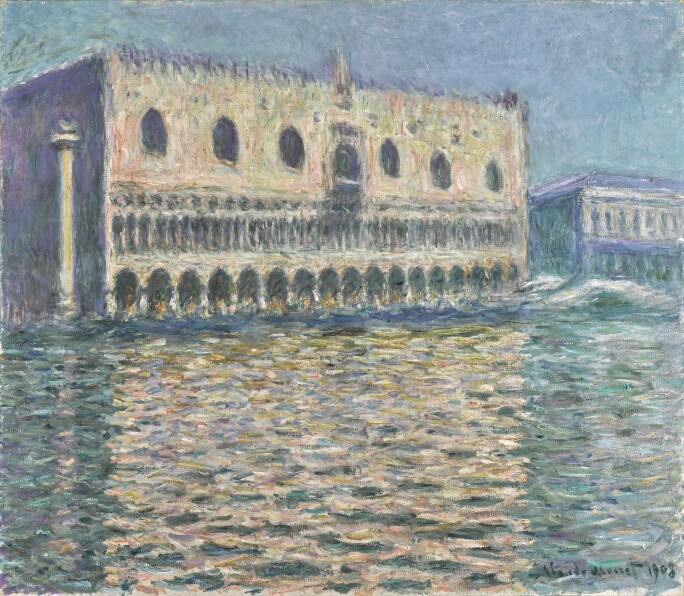P ainted from a moored boat, the scene depicts a close view of Palazzo Ducale, with its Byzantine fenestrations adorning the façade. The Ponte della Paglia and the prison building are visible on the right, while the column on the left of the palace marks the entrance to Saint Mark’s square. Monet painted two other views from the same vantage point – one of which is now in the collection of the Brooklyn Museum in New York – exploring the building and its reflection in the water in different light conditions.

The artist and his wife Alice stayed in Venice from October to December 1908, a trip that resulted in thirty-seven canvases on a variety of Venetian subjects; the Grand Canal, San Giorgio Maggiore, the Rio della Salute, the Palazzos Daria, Mula, Contarini and the Doge’s Palace.
More recently, Le Palais Ducal was included in the recent highly acclaimed exhibition Monet & Architecture at the National Gallery in London; discussing the present work and its companion-painting, Richard Thomson wrote in the exhibition catalogue: "Light plays on the façade, vividly reflecting the long block of the building in the sea. Monet used contrasts of value economically to characterise the famous architecture, darker patches marking the arcades, galleries and windows along the forbidding frontage, light picking out the column at the left against shadow […]. Paradoxically, given the enclosed, grimly private mien of the Doge’s Palace, Monet painted these canvases in sumptuous chromatics: angelica greens, banana yellows and turquoise blues" (R. Thomson Monet & Architecture p. 200).

Monet and Alice travelled to Venice for the first time in the autumn of 1908 at the invitation of Mary Young Hunter, a wealthy American who had been introduced to the Monets by John Singer Sargent. They arrived on 1st October and spent two weeks as her guests at the Palazzo Barbaro, which belonged to a relation of Sargent – Mrs Daniel Sargent Curtis. From the balcony of the Palazzo Barbaro, situated on the north side of the Grand Canal, they could see three of the great palaces Monet was to paint during his time in Venice: Palazzo da Mula, Palazzo Dario and the Palazzo Contarini.

They then relocated to the Grand Hotel Britannia, which provided him with views of the church of San Giorgio Maggiore and the Palazzo Ducale. Monet painted the celebrated Doge's Palace from three different viewpoints: a close view seen from the water; a view across the canal from the islet of San Giorgio Maggiore and one showing the palace from the other side, looking west, possibly seen from a floating pontoon.
Initially reluctant to leave his house and garden at Giverny, Monet must have sensed that the architectural splendours of Venice in their watery environment would present new and formidable challenges. His first days in Venice seemed only to confirm his initial fears but after several days of his customary discouragement, he commenced work on 7th October.

Matisse noted: "it seemed to me that Turner must have been the link between the academic tradition and impressionism" and divined a special connection between Turner’s works and Monet’s. Writing in the catalogue for the Turner, Whistler, Monet exhibition at Tate Britain in 2005, Katherin Lochnan pinpoints the Venice pictures as the culmination of Monet’s discourse with those two painters: “These beautiful and poetic works are portals through which the viewer can enter a world of memories, reveries and dreams. Fearing that they might constitute the final chapter in his artistic evolution, Monet sounded in them the last notes of his artistic dialogue with Turner and Whistler that had been central to his artistic development”.
In Venice Monet continued to observe, as he had in the views of the river Thames he completed in 1904, how light reflected off a wide stretch of water dissolves and liquefies the solid, uneven surfaces of stone walls. In Venice, however, the closeness of the buildings to the water's edge led him to explore more abstract compositions, accentuating the interplay between the ornate façade, with its arched openings and horizontal divisions, and the rhythmic expanse of water.

The glorious late canvases that Turner produced in the early 1840s, such as Venice, The Bridge of Sighs (fig. 4), present a Venice which is transfigured by light. Similarly in the present work Monet has suffused the very bricks and mortar with yellow, pink and purple tones. In his introduction to the Bernheim-Jeune exhibition, Octave Mirbeau observed that the atmosphere in Monet's views of Venetian palaces was ‘mixed with colour as though it had passed through a stained-glass window’ (O. Mirbeau, quoted in ibid., p. 206).
The now legendary exhibition at Galerie Bernheim-Jeune, Claude Monet Venise, opened on 28th May 1912 and was greeted with considerable critical acclaim, not least by Paul Signac who viewed the Venetian canvases as one of Monet’s greatest achievements.
Writing to Monet he states: “When I looked at your Venice paintings with their admirable interpretation of the motifs I know so well, I experienced a deep emotion, as strong as the one I felt in 1879 when confronted by your train stations, your streets hung with flags, your trees in bloom, a moment that was decisive for my future career. And these Venetian pictures are stronger still, where everything supports the expression of your vision, where no detail undermines the emotional impact, where you have attained the selflessness advocated by Delacroix. I admire them as the highest manifestations of your art” (P. Signac quoted in Turner, Whistler, Monet (exhibition catalogue), op. cit., p. 207).







